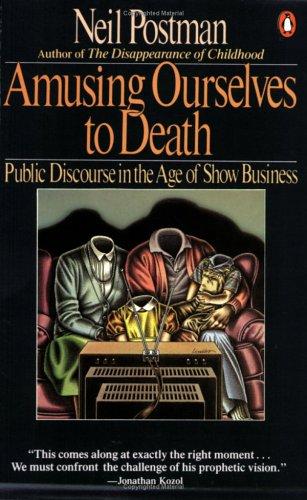Introduction
“Amusing Ourselves to Death” by Neil Postman is a profound exploration of how television, as a dominant medium, has reshaped the fabric of public discourse. Postman argues that the shift from a print-based to a visual-based culture has led to a decline in the quality of public discourse, as entertainment values increasingly pervade politics, education, and religion. This summary will delve into the book’s core frameworks and concepts, key themes, and conclude with a synthesis that applies these insights across various domains.
Core Frameworks and Concepts
Postman introduces the concept of the “media-metaphor” to illustrate how different media influence the way we perceive and process information. He posits that each medium has its own epistemology, shaping not only the content we consume but also the way we think. This framework is pivotal in understanding the book’s argument that television has transformed public discourse.
Media as Epistemology
Postman explains that every medium conveys information in a manner unique to its form. For instance, the written word encourages linear, rational thought, while television, with its emphasis on visual imagery, fosters a fragmented and superficial mode of understanding. To illustrate, consider how reading a detailed article in a newspaper allows for in-depth analysis, whereas a television segment on the same topic might prioritize visual appeal over depth.
The Age of Typography vs. The Age of Television
Postman contrasts the “Age of Typography,” characterized by a print-based culture, with the “Age of Television,” where visual media dominate. In the Age of Typography, public discourse was rational and coherent, as seen in the Lincoln-Douglas debates, where candidates engaged in hours-long discussions. In contrast, the Age of Television prioritizes brevity and entertainment, often at the expense of substance.
The Decline of Public Discourse
Television, according to Postman, has led to a decline in the quality of public discourse. He argues that the medium’s emphasis on entertainment has trivialized serious topics, turning news into infotainment and politics into showbiz. A poignant example is the shift in political debates, where sound bites and image management overshadow policy discussion.
The Impact on Politics, Education, and Religion
Postman expands his critique to specific societal domains:
-
Politics: The transformation of political discourse into entertainment is evident in the way candidates are marketed more like products than leaders. Television emphasizes charisma and visual appeal, which can overshadow substantive policy discussions. This shift parallels the concerns raised in “The Image” by Daniel J. Boorstin, where image and spectacle replace genuine engagement.
-
Education: In education, the need to entertain has infiltrated classrooms, where learning is increasingly mediated by screens. The focus on engagement often dilutes educational content, a theme echoed in “The Shallows” by Nicholas Carr, which examines how digital media reshape our cognitive processes.
-
Religion: Postman critiques televangelism, where the sacred is packaged as entertainment, thus diminishing religious experiences to mere spectacle. This mirrors the arguments in “The Medium is the Massage” by Marshall McLuhan, emphasizing how media alter our perception of reality and value systems.
Framework for Understanding Media Influence
Postman presents a framework to analyze how media shapes societal discourse:
- Medium-Message Relationship: Understand that the medium influences the nature of the message.
- Content Analysis: Evaluate how content is altered by the medium.
- Cultural Impact: Assess how media changes cultural norms and values.
- Audience Perception: Consider how audiences interpret messages differently based on medium.
These components provide a structured approach to dissecting media influence, offering a lens to critique modern digital platforms similarly.
Key Themes
1. The Shift from Print to Visual Culture
Postman details the societal shift from a print-based to a visual-based culture, emphasizing how this transition affects cognition and public discourse. The linearity of print encourages deep, sequential thinking, while visual media promote fragmented understanding. This theme resonates with the ideas in “Understanding Media” by Marshall McLuhan, who famously stated, “the medium is the message.”
2. The Trivialization of Public Discourse
Postman argues that television reduces complex issues to simplistic narratives. The need for entertainment leads to a preference for sensationalism over substance, a concern also reflected in “The Shallows” by Nicholas Carr, where the internet’s distractions undermine deep thinking.
3. The Commercialization of Politics
The book highlights how political processes are influenced by media’s entertainment values. Campaigns are crafted as marketing strategies, focusing on image over policy. This theme is supported by “The Image” by Daniel J. Boorstin, which critiques the transformation of politics into spectacle.
4. The Impact on Education
Postman explores how educational practices are reshaped by media’s need to entertain. The emphasis on engagement often comes at the cost of content depth. This aligns with Carr’s concerns in “The Shallows,” where digital tools change how we think and learn.
5. The Sacralization of Entertainment
Postman critiques how entertainment values permeate religious practices, turning sacred rituals into spectacles. This mirrors McLuhan’s argument in “The Medium is the Massage,” where media influence permeates all aspects of culture, altering the very fabric of societal values.
Final Reflection
Postman’s “Amusing Ourselves to Death” offers a timeless critique that extends beyond television to encompass all forms of visual media. His insights are increasingly relevant in today’s digital age, where social media platforms prioritize entertainment and engagement over substantive discourse.
By comparing Postman’s ideas with those of Boorstin, McLuhan, and Carr, we gain a richer understanding of how media shapes cognition, culture, and society. The frameworks and themes explored provide a lens to critically assess the influence of modern digital platforms, from Twitter’s character limits to Instagram’s visual storytelling.
In leadership, the emphasis on image management underscores the need for authentic communication. In design, understanding media’s influence can guide more effective user experiences. In change management, recognizing media’s role in shaping perceptions can inform strategies for organizational transformation.
Ultimately, Postman challenges us to be mindful of how media shapes our worldviews, urging us to reclaim depth and substance in our communication and interactions. This synthesis across domains highlights the enduring relevance of Postman’s work, as we navigate an increasingly media-saturated landscape.

